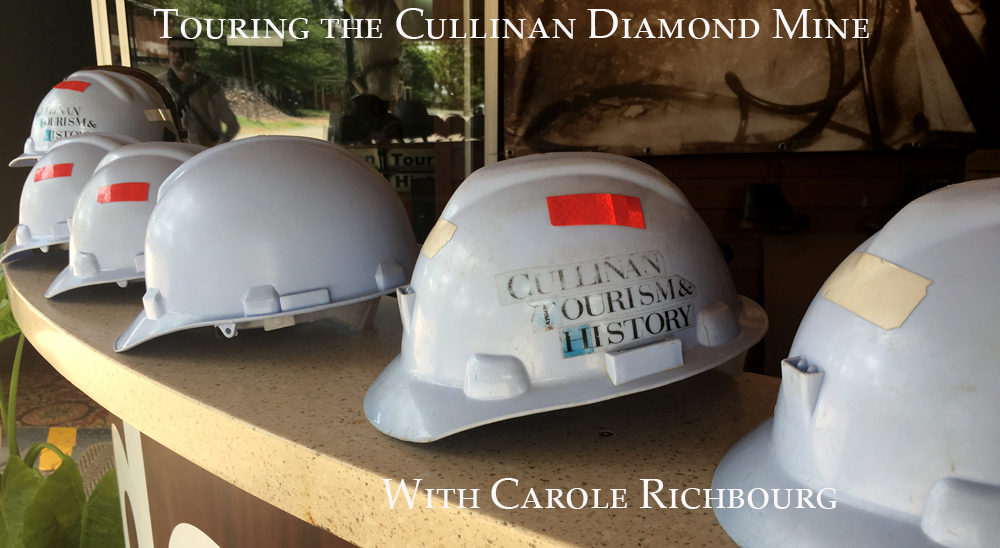Carole Richbourg, GG, FGA, ASA, Master Gemologist Appraiser® is an independent jewelry appraiser serving the Silicon Valley. A full-time appraiser since 1989, she has over forty years of broad experience in the jewelry industry.
[Article adapted for Kerns’ Blog from Jewelry Business Journal 2017)
CONTINUED FROM PART 1
When we left off in PART 1 our blog, Carole and her husband had just suited up and were ready to begin making their way to the bottom of the Cullinan Diamond Mine:
Trailing Henne, our underground guide, we walked a fair distance outdoors enroute to the elevator cage which would take us 783 meters (2568 ft) to the bottom of the mine. We walked past vast amounts of mined kimberlite, the rock closely associated with diamonds, which had come up from the mine. Two large elevators which draw up the mined kimberlite 60 times an hour, 24 hours a day, 7 days a week, and meters long conveyor belts where the crushed kimberlite trundles its way for processing. We also walked past large buildings which housed giant washers that we could hear sloshing nearby
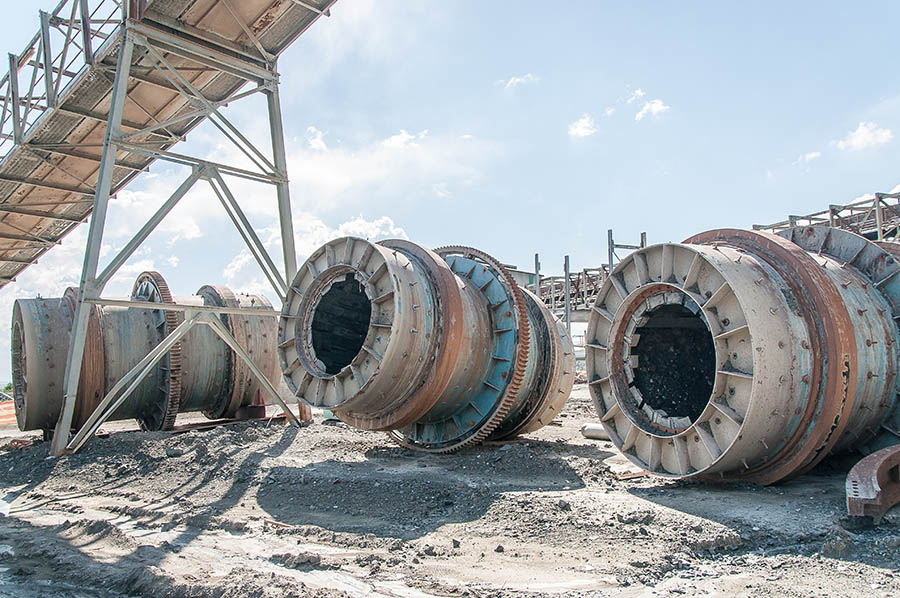
Old washer, they were as tall as two men.
Along the way, Henne told us about new technologies that use near-infrared (NIR) spectroscopy and x-ray transmission (XRT) imaging technology developed to mitigate damage to large valuable crystals. This is especially important for a mine such as the Cullinan, a source that frequently yields diamonds larger than 10 carats. Cullinan has produced over 800 stones weighing more than 100 carats, 140 stones weighing more than 200 carats and approximately a quarter of all diamonds mined weighing over 400 carats [see sidebar]. In addition, the Cullinan is the only reliable source for very rare and valuable blue diamonds.
We arrived at the cage, the only way in and out of the mine, and take the 2 ½ minute ear-popping ride underground alongside a full complement of working miners. When the heavy steel doors slid up and out of the way, a tired and dusty crew was waiting to go up. The miners work in shifts: 2 am-10 am, 10 am-6 pm and 7 pm-2 am. As the miners dispersed into different tunnels, we stuck closely to our guide so as not to get lost.
For those readers who might be a bit claustrophobic, once down at the bottom, the mine really feels quite spacious. Certainly, it is rustic with its roughhewn walls, dim light and everything covered with a thick layer of dust. The tunnels are still lined with unused trolley tracks and there is ample room to accommodate large trucks and heavy equipment. Overhead, one can trace color-coded pipes that bring in water and fresh air and clear away carbon monoxide. There are refuge rooms - easily found in the dark or emergency conditions - marked by amber light, and offices and break rooms.
Along the way, Henne told us about new technologies that use near-infrared (NIR) spectroscopy and x-ray transmission (XRT) imaging technology developed to mitigate damage to large valuable crystals. This is especially important for a mine such as the Cullinan, a source that frequently yields diamonds larger than 10 carats. Cullinan has produced over 800 stones weighing more than 100 carats, 140 stones weighing more than 200 carats and approximately a quarter of all diamonds mined weighing over 400 carats [see sidebar]. In addition, the Cullinan is the only reliable source for very rare and valuable blue diamonds.
We arrived at the cage, the only way in and out of the mine, and take the 2 ½ minute ear-popping ride underground alongside a full complement of working miners. When the heavy steel doors slid up and out of the way, a tired and dusty crew was waiting to go up. The miners work in shifts: 2 am-10 am, 10 am-6 pm and 7 pm-2 am. As the miners dispersed into different tunnels, we stuck closely to our guide so as not to get lost.
For those readers who might be a bit claustrophobic, once down at the bottom, the mine really feels quite spacious. Certainly, it is rustic with its roughhewn walls, dim light and everything covered with a thick layer of dust. The tunnels are still lined with unused trolley tracks and there is ample room to accommodate large trucks and heavy equipment. Overhead, one can trace color-coded pipes that bring in water and fresh air and clear away carbon monoxide. There are refuge rooms - easily found in the dark or emergency conditions - marked by amber light, and offices and break rooms.
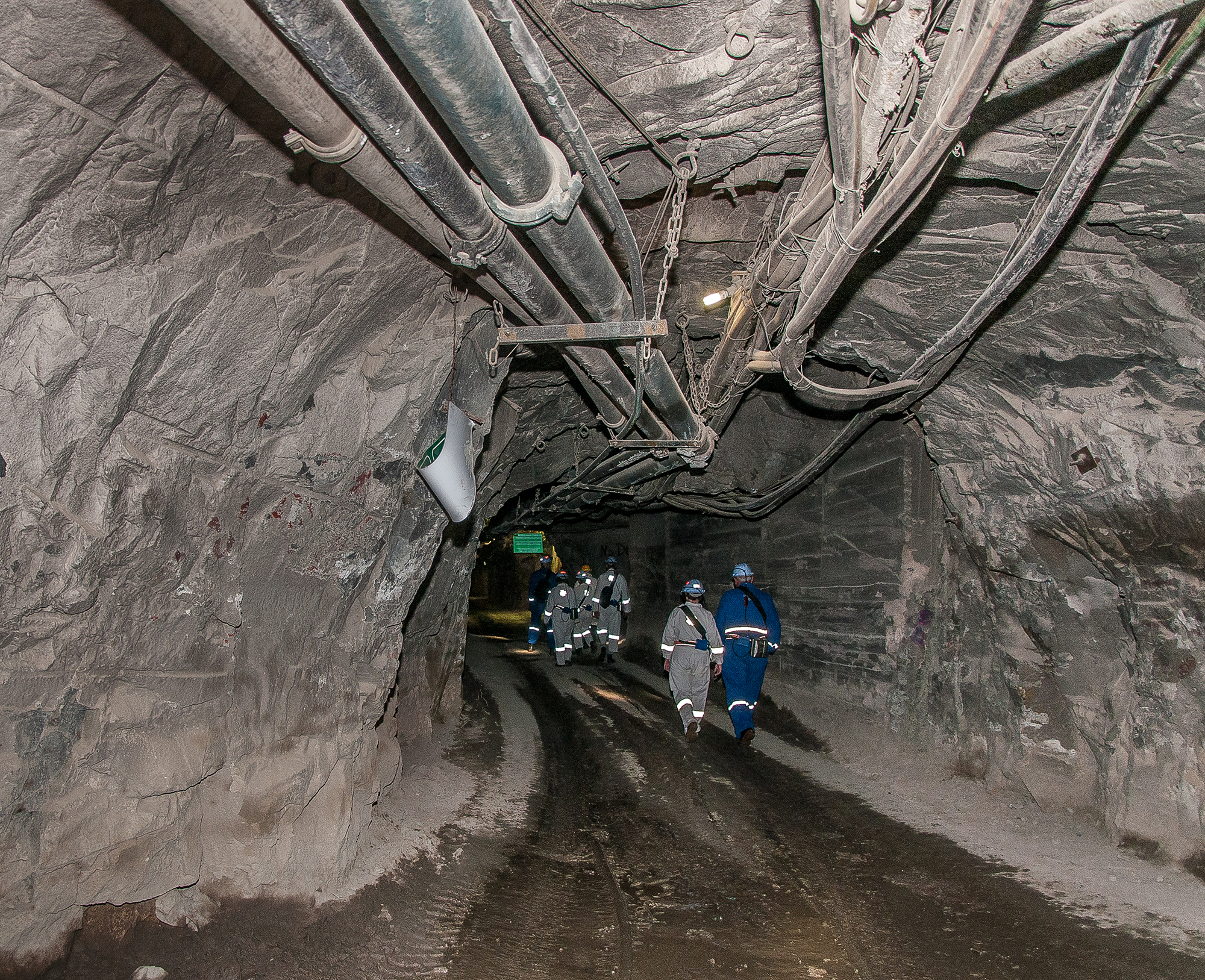
It’s bigger than you might think.
We walked the tunnels, hewn of solid bedrock, which support the work to extract and push along the unstable kimberlite for processing. Evidence of the kimberlite could be seen piled up around ground-level chutes that funnel the rock to the two huge elevators. The elevators bring the diamond-bearing rock up to the surface, where the process of crushing, washing and sorting begins. Some of the older chutes, as well as much larger equipment, are rusty and decommissioned, but it is not cost effective to dismantle them and remove them from the mine. There were also shafts that looked bottomless. It was here that we could pick up and examine pieces of the ‘blue ground’ or kimberlite. The dark sandy rock was damp and very crumbly, with shiny bits of chromite catching the light of our headlamps
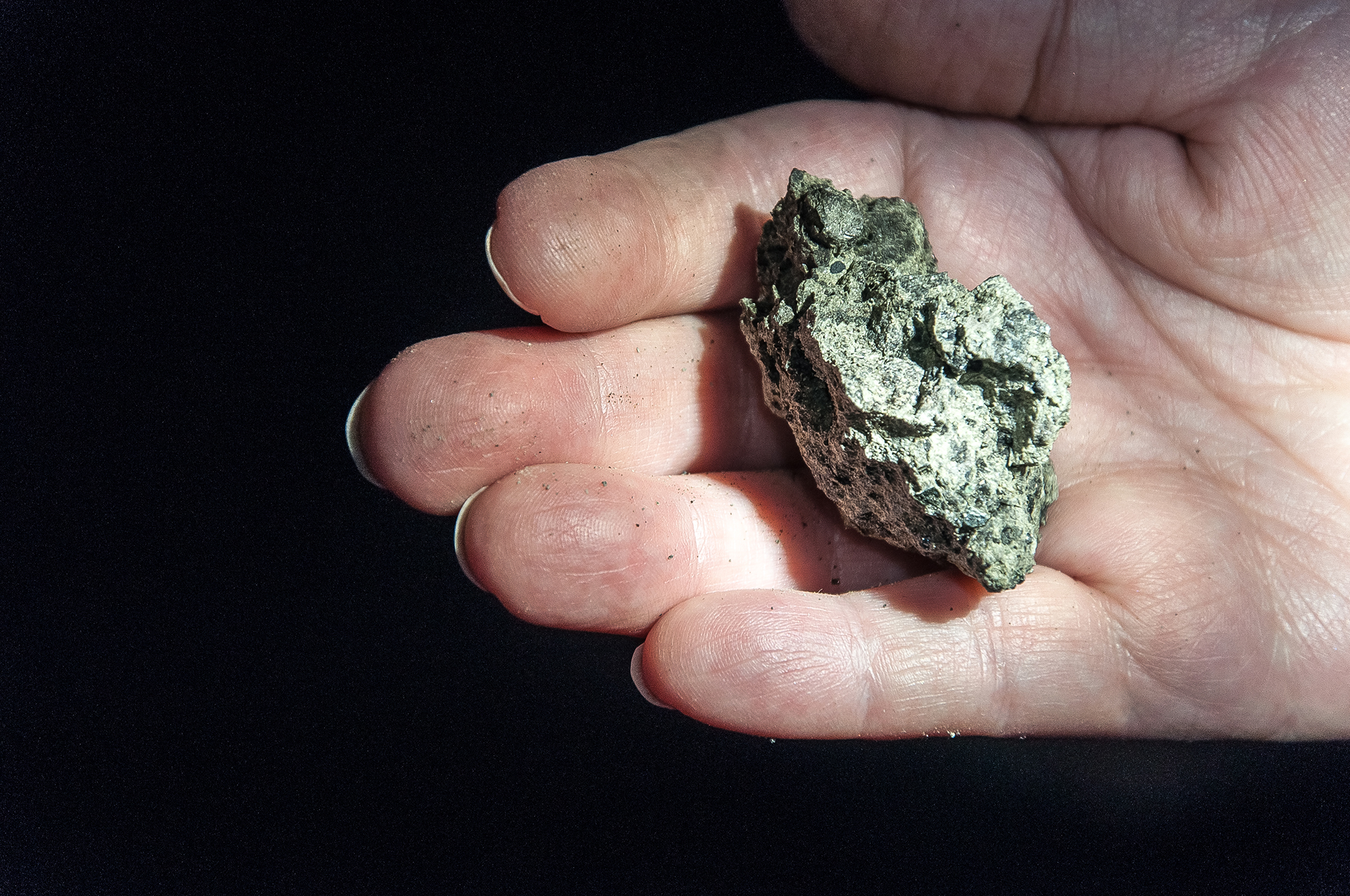
Kimberlite
Gone are the days of jamming sticks of dynamite into seams and running for cover. A clear gel which is non-volatile by itself is mixed with another chemical that turns the substance a thick, opaque blue. A carefully monitored electrical charge activates this explosive. As we passed containers of the blue ooze, Henne talked about the large piece of equipment used to move and activate this incendiary gel.
It’s easy for newcomers to get disoriented down in the mine. Most of the tunnels look alike, so we kept our headlamps trained in front of us, mindful of where we walked, trying to take everything in while we listened to his many stories about everyday operations, from the particulars of the two fatal accidents that happened while he was employed at the mine, to the future of mining prospects at Cullinan.
After what seemed like hours, (and slightly too-small boots) I started to recognize landmarks, and we were soon back to where we started. As we waited for the ride up, we welcomed the break, and spent the time to rest, take pictures with Henne and chat. We rode the elevator in silence, perhaps glad to be above ground but with a definite sense of admiration for the men and women that work in the mines.
After a short trek to view Cullinan’s “Big Hole” – amazing giant hole in the ground from decades of excavation – we returned to the tourist center for a cool drink, and a walk through the showroom where visitors can buy the trademarked Cullinan Star CutTM faceted diamonds. The proprietary cut is a round brilliant diamond with 66 facets, with certificate of provenance as verification the diamond was mined at Cullinan and has very limited distribution. Every stone is laser inscribed with the Cullinan Star Cut® Logo and is accompanied by a GIA Diamond Grading Report. I was pleased to learn that a percentage of the sale of every diamond is allocated to a Cullinan program that brings skills development and job creation to the town.
Also for sale was a replica of the famed Cullinan diamond, which now sits proudly on a shelf in my office as a symbol of the 783-m (2568-ft), 6000 steps, and 3.5-km (3-mile) trek it took to conquer Cullinan.
It’s easy for newcomers to get disoriented down in the mine. Most of the tunnels look alike, so we kept our headlamps trained in front of us, mindful of where we walked, trying to take everything in while we listened to his many stories about everyday operations, from the particulars of the two fatal accidents that happened while he was employed at the mine, to the future of mining prospects at Cullinan.
After what seemed like hours, (and slightly too-small boots) I started to recognize landmarks, and we were soon back to where we started. As we waited for the ride up, we welcomed the break, and spent the time to rest, take pictures with Henne and chat. We rode the elevator in silence, perhaps glad to be above ground but with a definite sense of admiration for the men and women that work in the mines.
After a short trek to view Cullinan’s “Big Hole” – amazing giant hole in the ground from decades of excavation – we returned to the tourist center for a cool drink, and a walk through the showroom where visitors can buy the trademarked Cullinan Star CutTM faceted diamonds. The proprietary cut is a round brilliant diamond with 66 facets, with certificate of provenance as verification the diamond was mined at Cullinan and has very limited distribution. Every stone is laser inscribed with the Cullinan Star Cut® Logo and is accompanied by a GIA Diamond Grading Report. I was pleased to learn that a percentage of the sale of every diamond is allocated to a Cullinan program that brings skills development and job creation to the town.
Also for sale was a replica of the famed Cullinan diamond, which now sits proudly on a shelf in my office as a symbol of the 783-m (2568-ft), 6000 steps, and 3.5-km (3-mile) trek it took to conquer Cullinan.
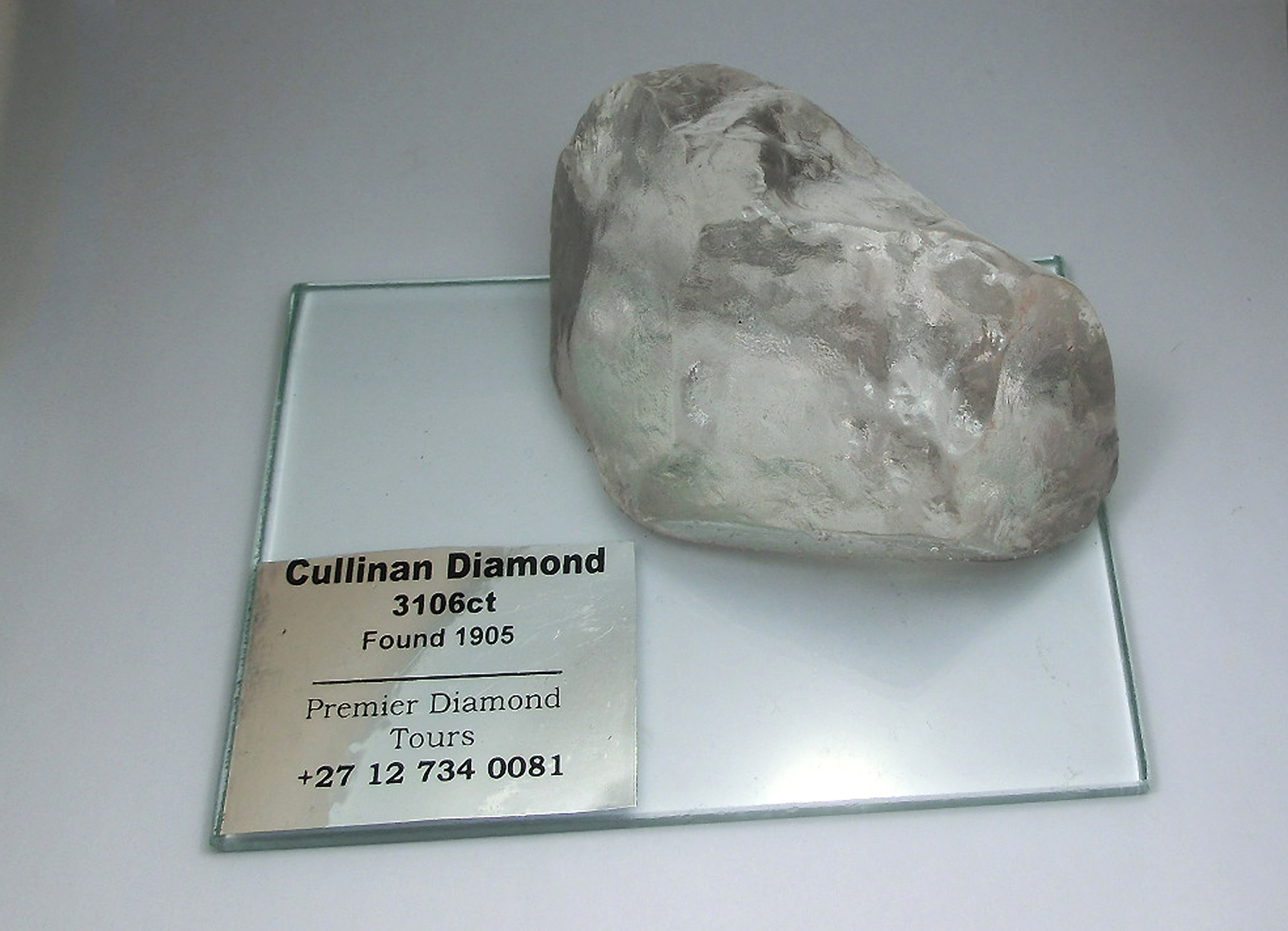
Cullinan replica
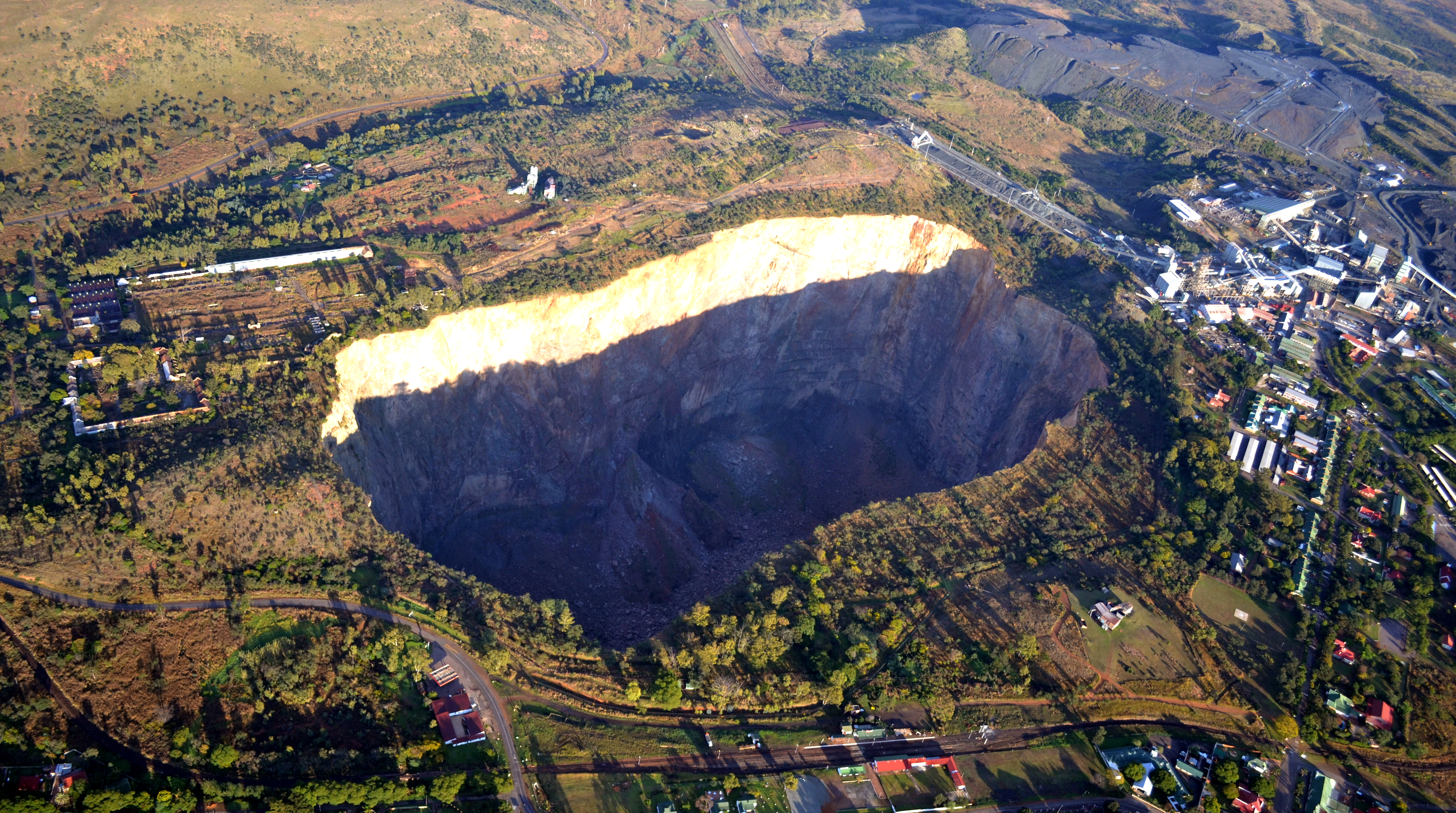
"Big Hole"

